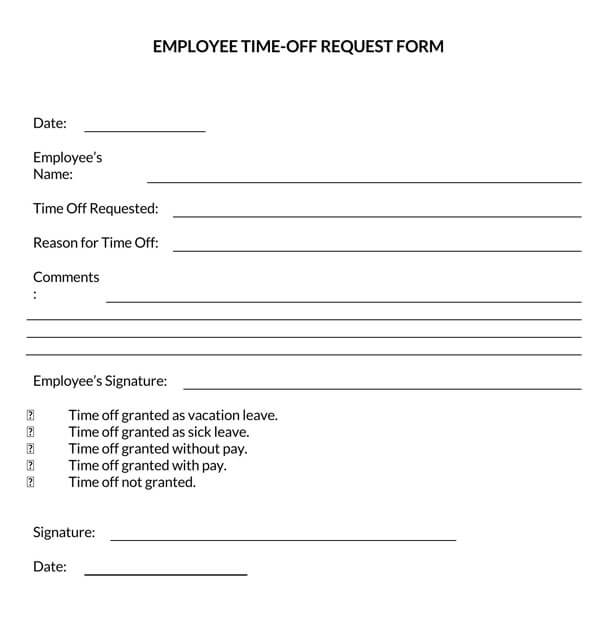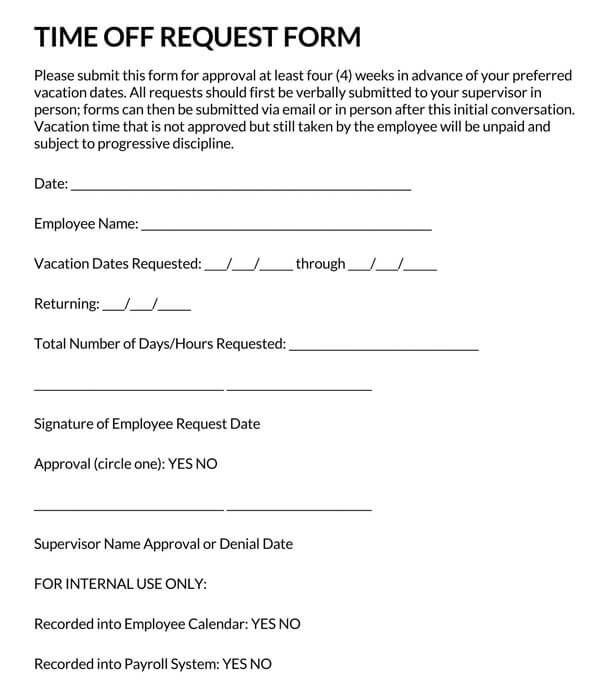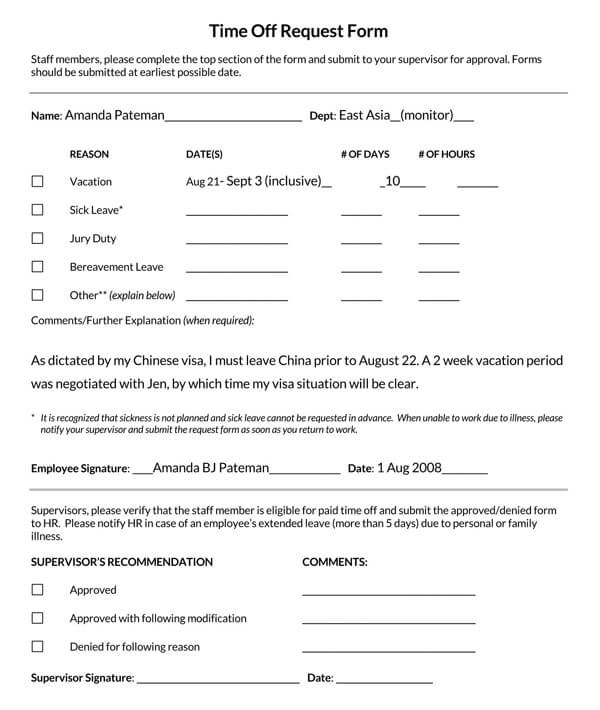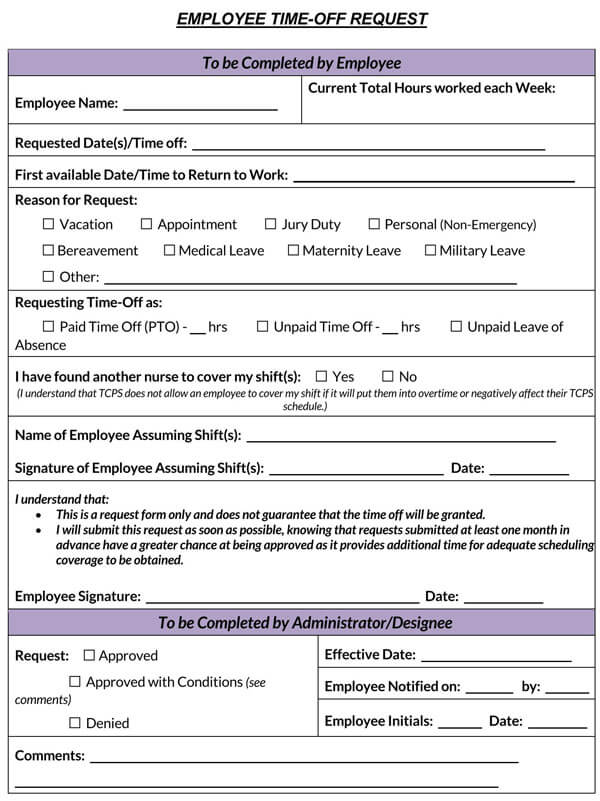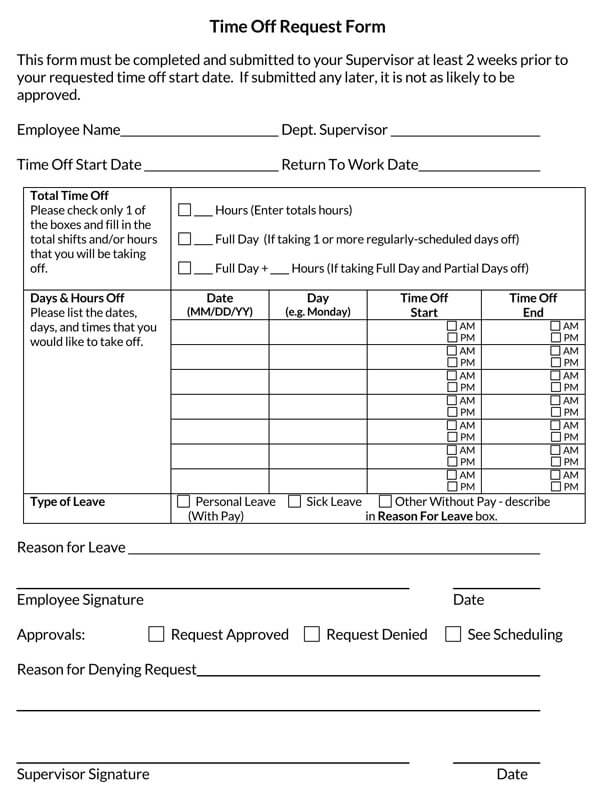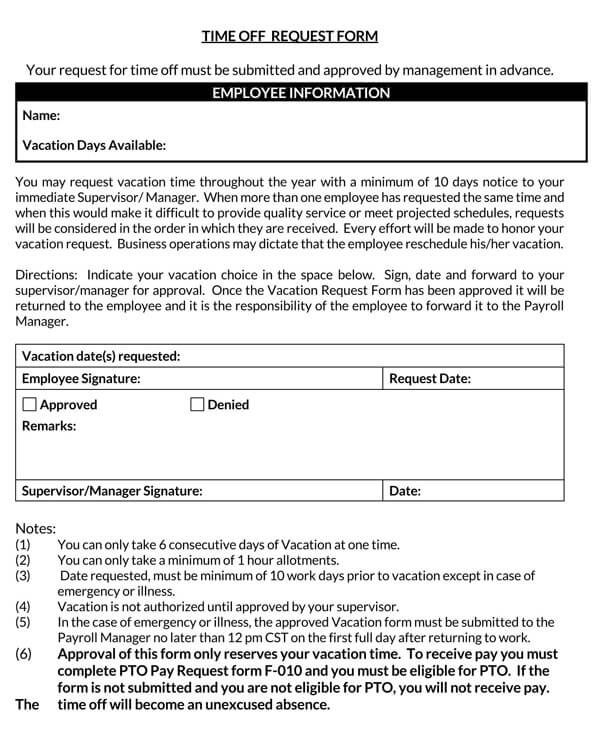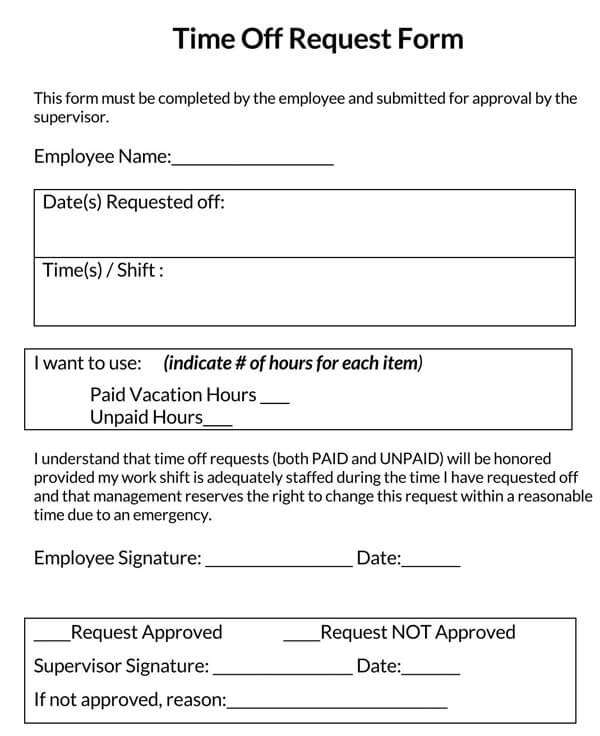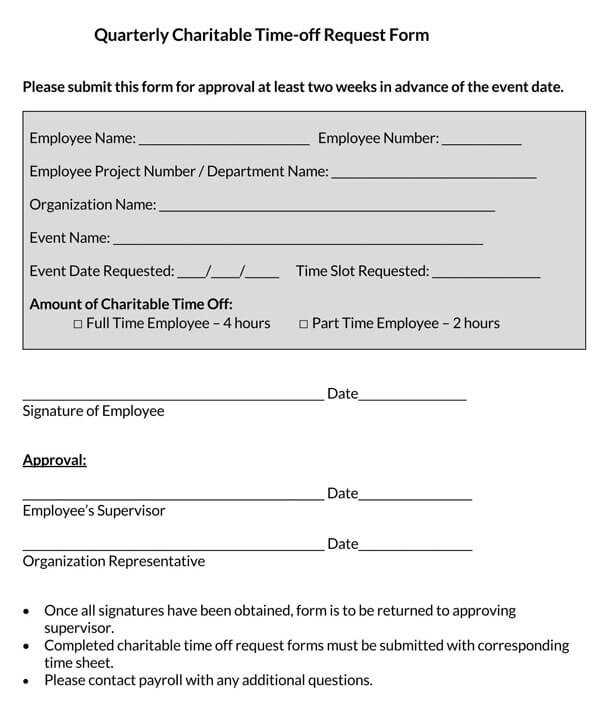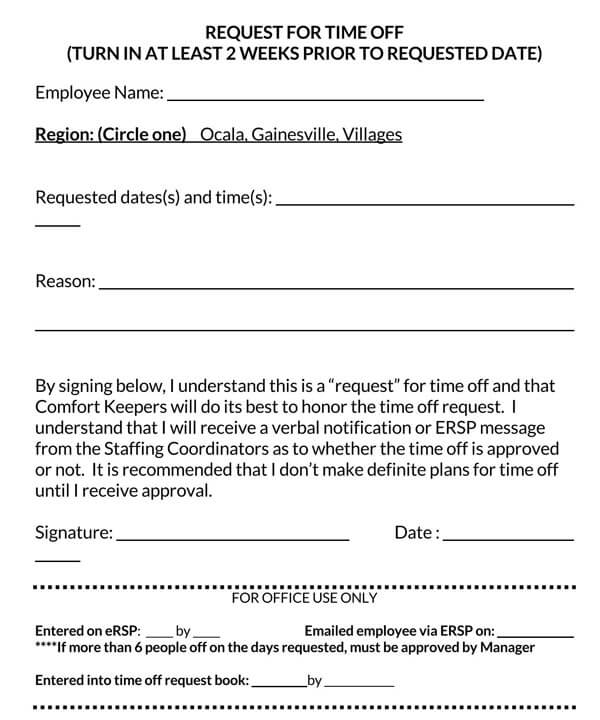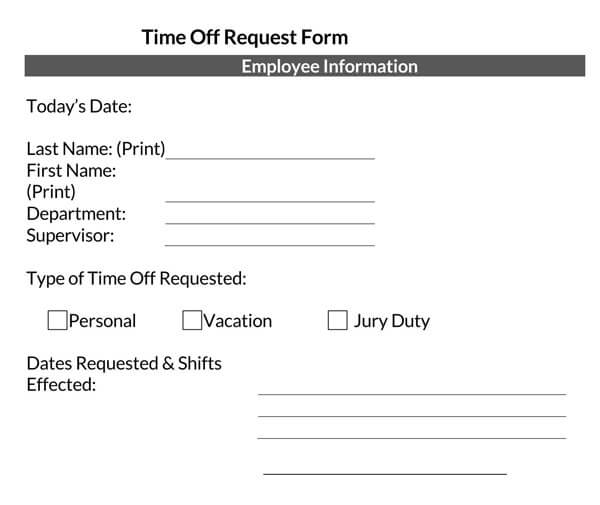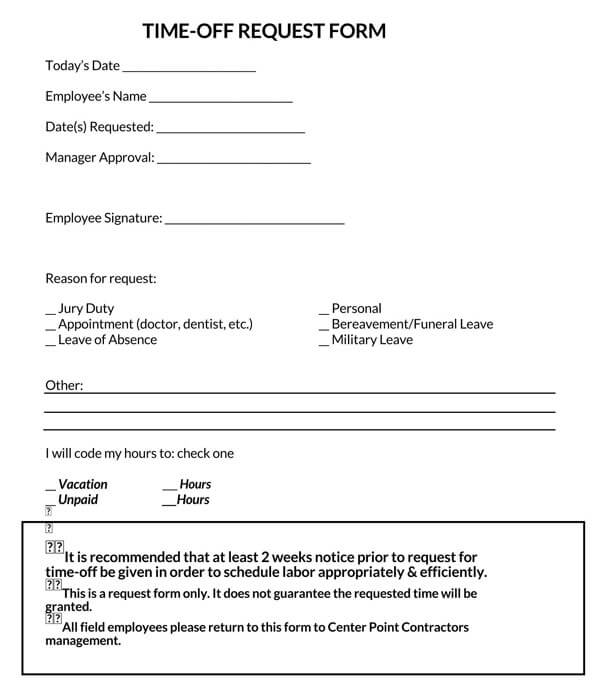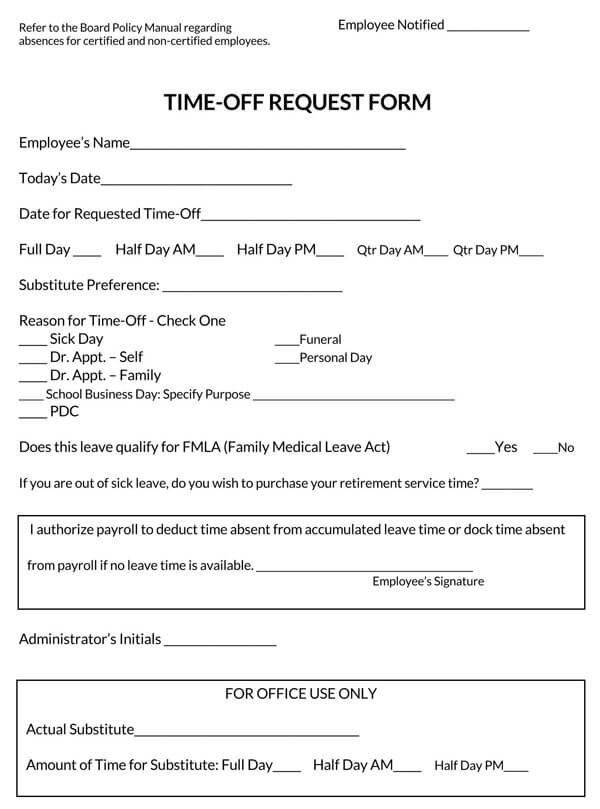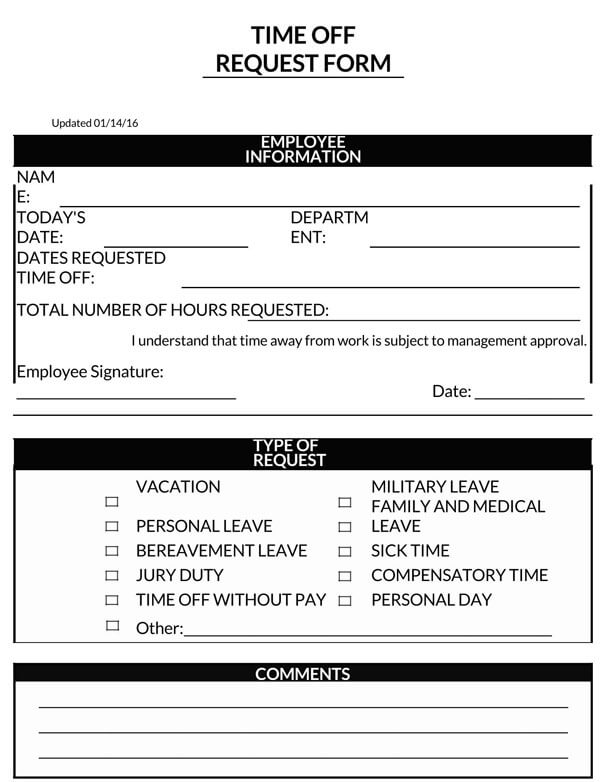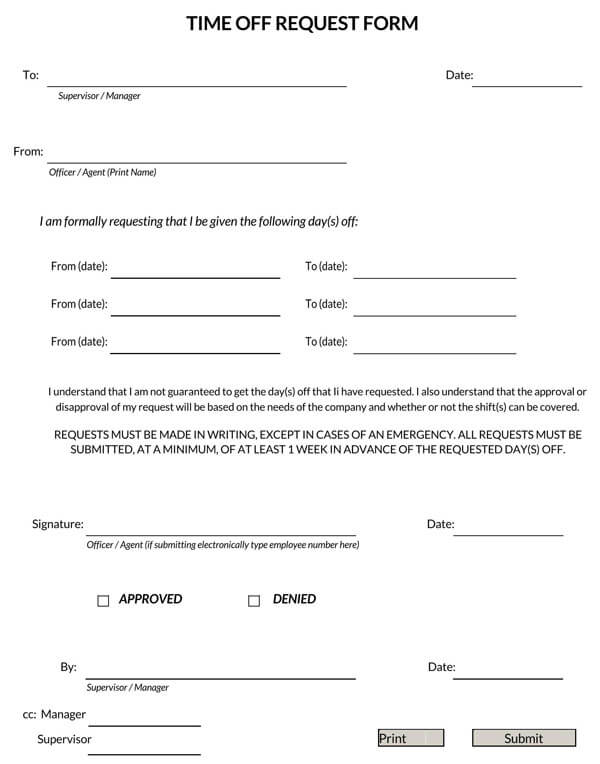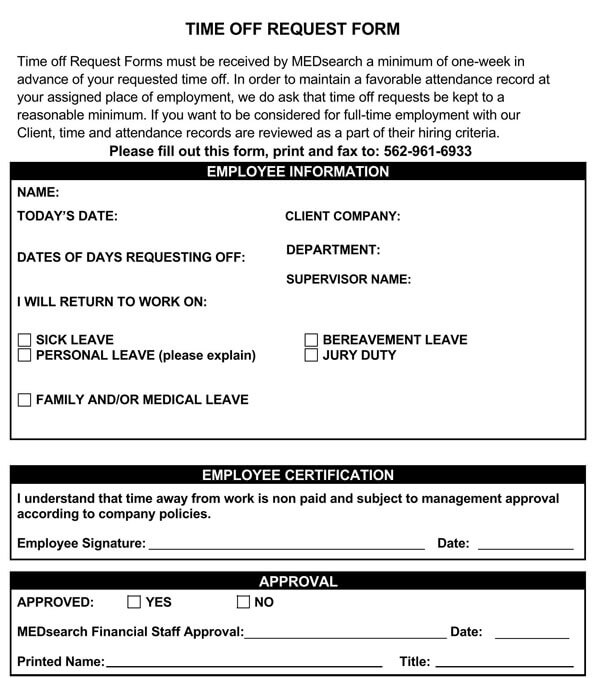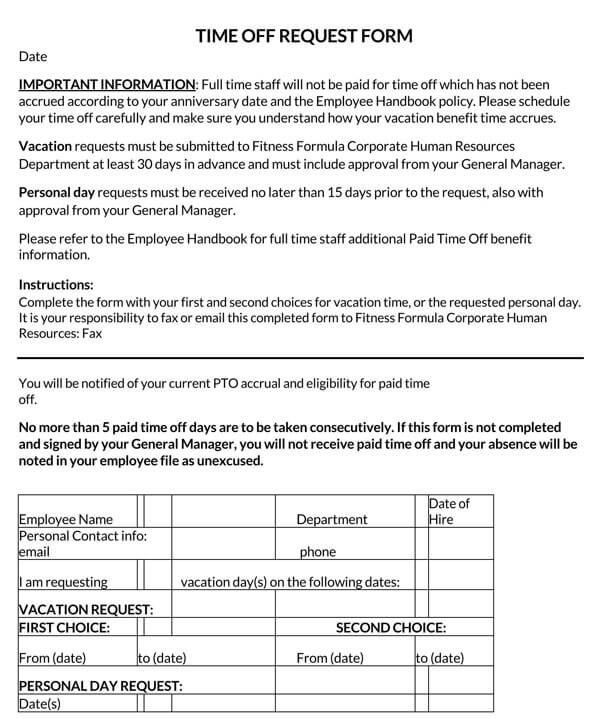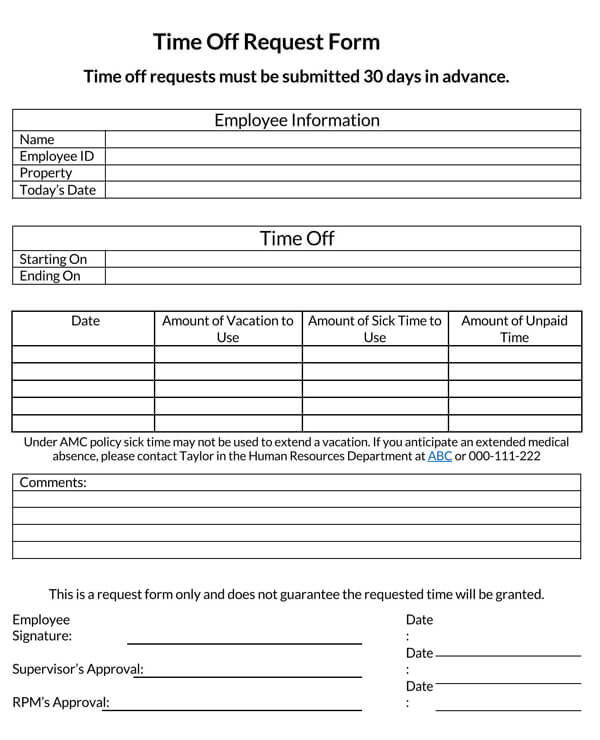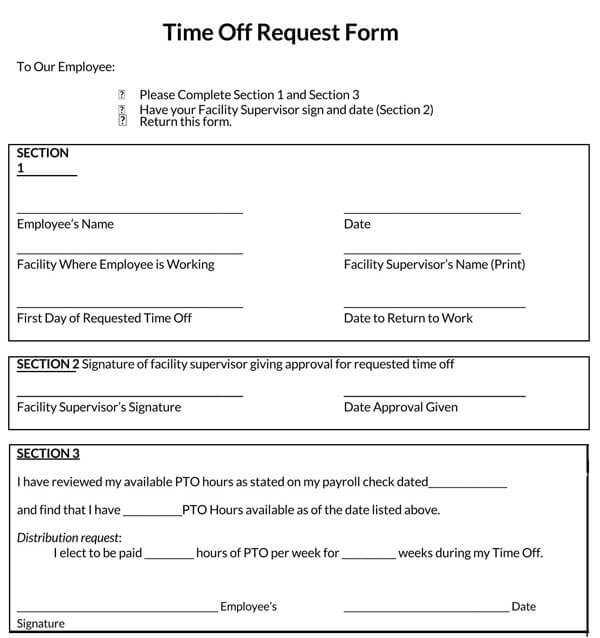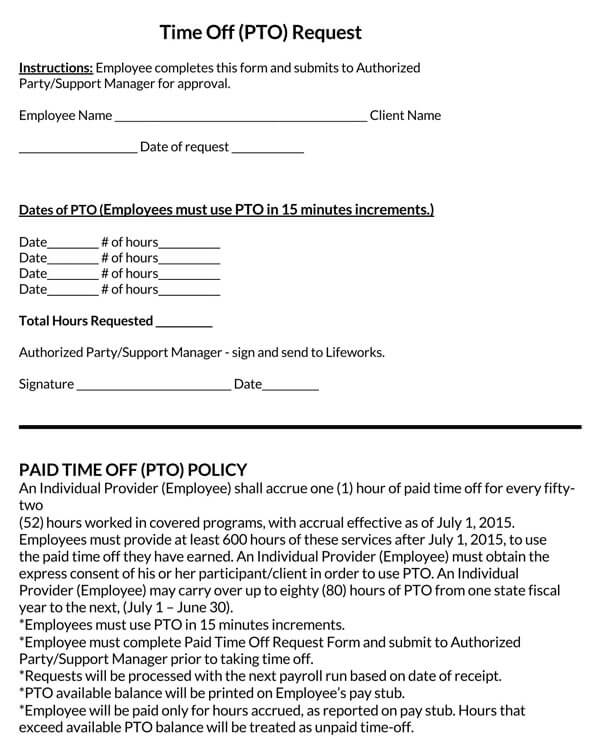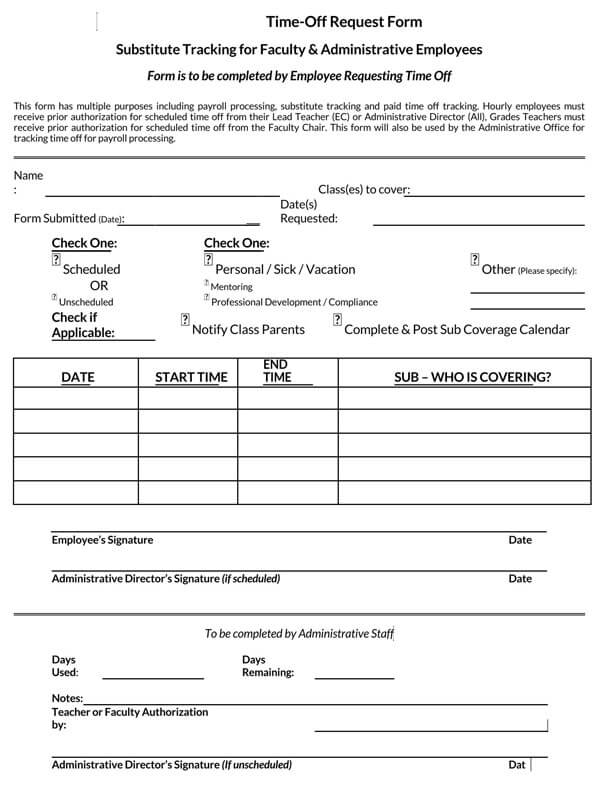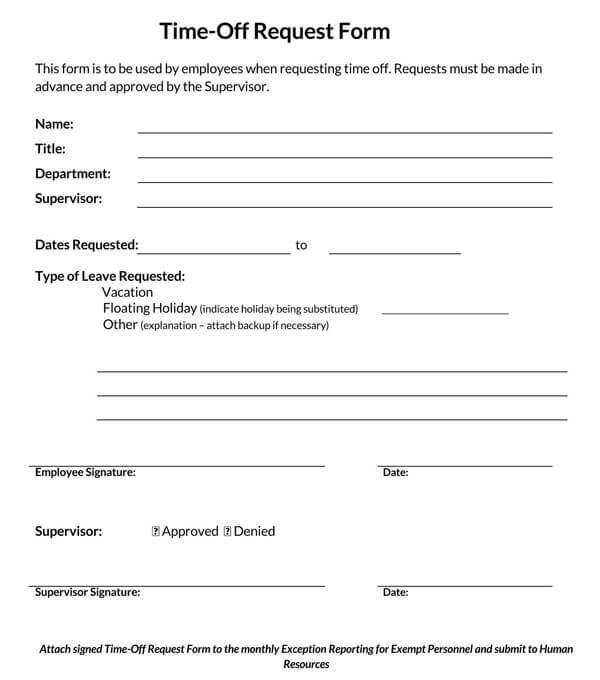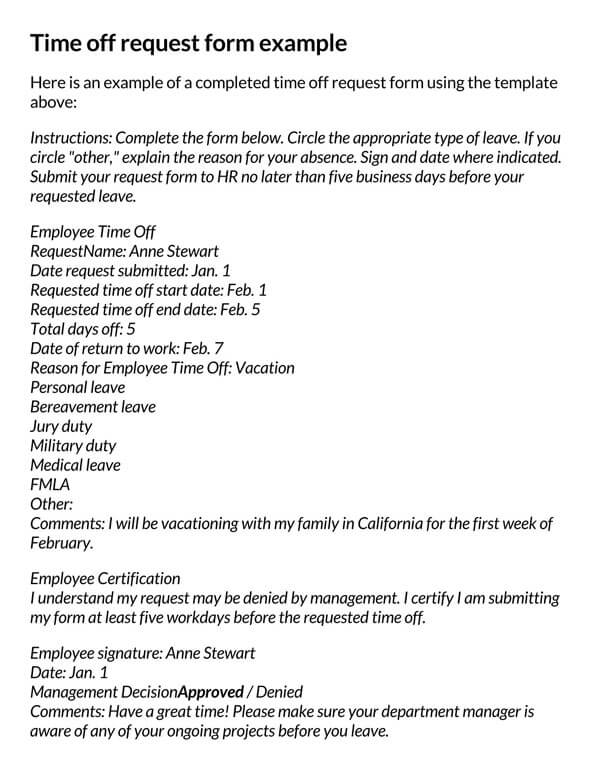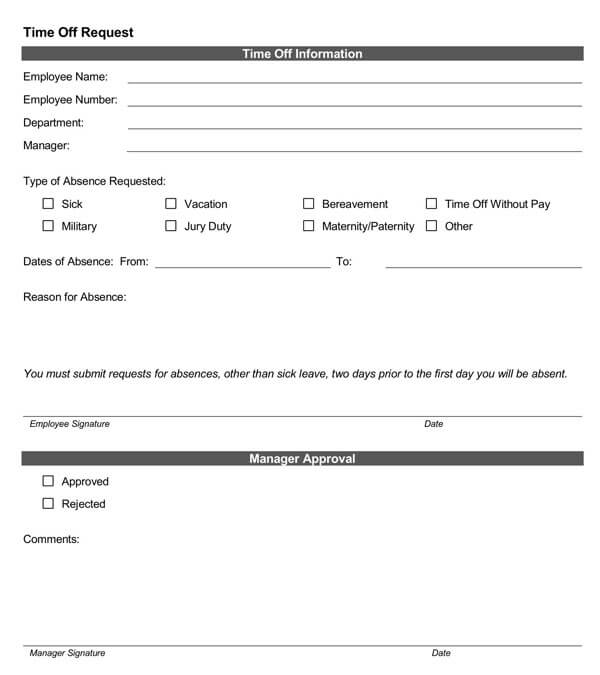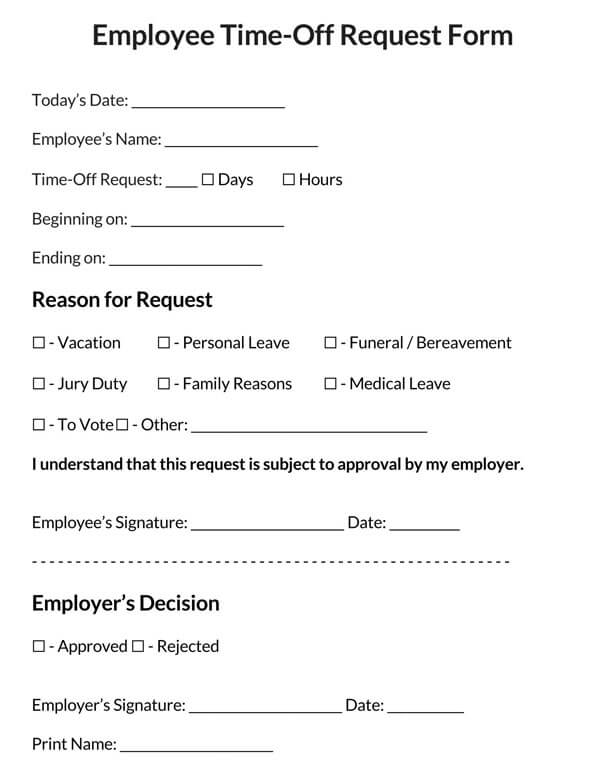An employee time off request form is a form that an employee fills and submits to an employer when they wish to go for a vacation.
Employees should notify their employers of their plan to take time off work—forms for seeking time off help simplify the process of requesting time off for vacation. Your employee(s) may express their intention to be absent at a specific time and for a genuine reason by submitting a time-off request. Time off can be taken for several reasons, including the need for a holiday, illness, maternity leave, personal time, or some other valid reason.
Free Templates
Download free customizable employee time off request form templates from here.
Importance of Employee Time Off Request Form
Advanced notice of time off from an employee helps the company cover shifts for the employee. If an employee is taking leave for a long vacation, the time off request form will detail the expected dates of the leave and enable the employer to prepare a temporary replacement. Forms for requesting time off are formal and professional monitoring documents.
Employers should maintain a list of all the time off an employee has taken to measure compensation or time owed if the employee leaves the business. An advanced time off notice will help you and the company to find a stand-in for an employee if necessary. The time off request form provides the expected dates of the leave; therefore, training for a temporary replacement can be done.
Inquiries for time off could be made on paper or electronically. The type of time-off requests differs depending on the employee’s rank in the company or the type of employment. A time-off application, for example, can be more of a declaration than a request in white-collar professions. It is always part of a formal process for blue-collar jobs in accordance with corporate policy. Essentially, it is important to recognize that both approaches are suitable.
Permitting Time Off from Work
As an employer, time off for requests is a regular occurrence. In this part of the article, we have explained the steps of granting time off from work requests.
The steps include:
Identify the type of time off
If a worker would like to take time off from work, determine the type of time off he/she is requesting.
The common types of time off are:
- Vacation
- Health/Disability – Sickness, illness, surgery, etc.
- Break from Work
- Bereavement
- Jury Duty
- Military
- Maternity/Paternity
- Leave of Absence (Short or Long Term)
Invite your employee to discuss
Consult with your employee in advance of the time of request to prepare for a replacement. Other aspects can be considered, like if a request is made during a busy or peak season when workers are needed or whether the time off is paid or not. There is no federal law dictating how many paid days off an employee can have each year. However, ten paid days off is the national average, according to the Bureau of Labor Statistics. Furthermore, it indicates that, on average, employers give an additional eight days off for federal holidays.
Ask the employee to submit a formal request
Once the employee has discussed the type of request with you or the human resources department, it should be presented formally. The total number of days with dates should be specified in the request. If the employee is taking time off due to extenuating circumstances, they should give all specifics and estimated return dates. Following submission, you should decide within forty-eight hours if you will grant the request.
Preparing and Implementing Time-Off Policies
It is important for an employer to know how to create a time off request form. In this part of the article, we have explained the steps to create and utilize the time off request form in detail.
The following steps should be followed in order to prepare and implement the policies;
Initiation
The first step is initiation. If the workers are unionized, be aware of the union guidelines. Union employees are often required to take time off. Employees who would like to work on a holiday or during a period of high employee time off should be rewarded with a bonus. Also, decide a compensation formula for employees who choose to work on a holiday or bear the inconvenience of working during high employee absence (time-off).
Identify the required information
Establish what information you need from employees in order to accept or refuse time off. Normally, this contains the requested dates and the purpose for the time off. Some workplaces, such as schools, require the recruitment of a substitute teacher or creating lesson plans. Include these conditions on the policy form.
A few guidelines that can be followed in order to make this step of the policy implementation procedure more efficient are as follows;
- Plan ahead: Keep an eye out for major holidays or events in your city. Check with your staff some weeks before popular leave periods to ensure you have a proper backup.
- Simplify the policy: To avoid confusion during the time-off request process, aim to keep your policy simple but detailed.
- Create a leave calendar: Create an employee leave schedule so that all workers are informed of when the company will be understaffed. Employees will be able to self-regulate their leave as a result.
Give instructions
Create a simple series of steps for the employee to take to correctly complete and submit the time off request form. This could include how long in advance they can submit their form, whom they should send it to, and how they will be notified of acceptance or rejection. It is vital to keep track of employees’ past vacation time to ensure they are not exploiting the policy. Set clear deadlines for seeking extended time off. Nevertheless, be flexible in circumstances such as unexpected illness or grief.
It is also essential to identify between requests for vacation and those for medical leave. Medical time-off requests should be prioritized, and if granted, an employee should not be refused vacation leave.
Create a fillable time off request form and make copies
Create a writable form now that you have a list of the details you need from employees and the process by which they can seek leave. A fillable form can be done either online or by hand. Make copies of the time off request form for each employee. Depending on the company’s submission process, these may be physical copies or links to a digital or online form.
Communicate the policy to employees
Confirm that all employees know of the processes for seeking time off. Add the policy in the employee handbook and a copy of the time off request form template. Start by verifying the policy on time off requests with Human resource management. After all forms and procedures have been approved, develop a strategy for informing employees. Send an email defining the latest time-off application policy if you have a big organization or several employees who work remotely.
Hold an in-person meeting to discuss the new policy if the company is small and everyone works in the same place. If your company is open on national holidays, consider implementing a rotating holiday schedule to avoid having the same employees working such days every year. Lastly, if several people seek time off simultaneously, use seniority to decide who gets it.
Post the form
Make copies of the time off request form available for employees to use. This could be done online through a business site, a communal local office drive, or a document in the office. Establish which methods work best for your employees.
- Include an employee handbook: In the employee handbook, include a written copy of the policy, time off request form, and procedure for both current and potential employees.
- Increase employees’ reach on time off request forms: Make copies of each employee’s time off request form. Depending on the company’s submission process, these may be physical copies or links to a digital or online form.
- Create online systems: Build an online or computer-based time off request form system if necessary. This reduces the amount of hard copy you have to track and allows staff, supervisors, and HR to easily access previous leave forms.
- Automate the process: Automate as much of the time off request process as possible. For example, if a form is filled online, have it automatically forwarded to the authorized person.
- Integrate into your human resource information system: This is an excellent system for maintaining records.No sticky notes get lost, and the system automatically labels a day off as a holiday or sick leave. A standard system would also direct requests to the appropriate individual, so there is no uncertainty about whether “well, Kevin said I could have time off,” only to discover that Kevin lacked the necessary authority. You may frequently customize to provide the details you need and apply your own rules (seniority, first-come, first-served, no requests before a specific date). This greatly simplifies record-keeping and fairness.
Set period of time to accept requests
Allowing people to request time off as much in advance as they want would result in a great employee choosing the best times and requesting them three years in advance. While this approach can allow for preparation, other employees might object. Instead, provide fair guidelines for requesting time off, such as not more than a year in advance, or that all summer requests must be made by 31st March. Restrict your employees’ ability to schedule trips with friends and family or even get fair prices on holidays if you suggest they can’t request more than two months in advance.
Avoid denying already approved time off
People schedule ahead of time. Their partners plan vacations, buy plane tickets, and reserve hotel rooms. If you say “yes” in October and then “oops, never mind” in December, it is unfair to the employees.
Separate vacation days from medical days off requests
The law requires you to give sick days and time for workers to visit physicians, undergo medications, or counseling. Usually, it would be best if you went to the doctor at the time specified by the doctor’s office, which workers cannot easily reschedule. These requests must be given top priority.
Ask few personal questions
If there is a dispute and many people want to have the same day off, decide based on the scheduled event. However, if anyone needs a day off and they have the available vacation time, and the company would not cease to function without them, the response should be yes. Asking “why” makes workers feel pressured to explain their time off.
In order to do so, follow the following guidelines throughout the policy implementation process;
- Limit restrictions: Try to keep time off limitations to a minimum. Rather than creating a general refusal policy, treat each request individually.
- Implement trade shifts: If several workers need the same day off and you need to avoid asking too many questions, urge them to simply exchange shifts to preserve work coverage while still receiving the time off they need.
- Give bonuses: If there are employees who would like to work on holidays or during a high employee time off, reward them with bonuses.
- Be encouraging: Encourage your staff to take advantage of the vacation time that is available to them. Overworked employees will be less efficient and harm the company’s morale.
Employee Time Off Request Sample (Vacation)
Name: Kevin Brandt
Date request submitted: 3rd February
Requested time off start date: 9th February
Requested time off end date: 16th February
Total days off: 8
Date of return to work: 17th February
Reason for Employee Time Off: Vacation
Personal leave
Bereavement leave
Jury duty
Military duty
Medical leave
FMLA
Other:
Comments: I will be on vacation with my family for the first and part of the second week of February.
Employee certification
I realize my request may be denied by management. I certify that I am sending my form at least five business days before the requested time off.
Employee signature: Kevin Brandt
Date: 3rd February
Management Decision: Approved/ Denied
Comments: Have a fantastic time! Before you leave, please make sure your department manager is aware of any current tasks.
HR signature: Brian Stone
Date: 4th February
Frequently Asked Questions
How can you manage time-off requests?
Determine how long in advance and how often time off should be sought, create a framework for dealing with conflicting demands, assemble a list of potential replacements for backup employees, and set periods within which workers cannot request time off.
Can an employer deny unpaid time off?
Non-exempt workers are only compensated when they work. According to the Fair Labor Standards Act, an employer can authorize unpaid vacation leave at any time. Unpaid time off can result in deductions for exempt employees.
